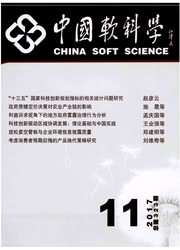

 中文摘要:
中文摘要:
在我国经济发展过程中资源环境约束日趋强化的背景下,本文对经济增长效率概念进行了重新界定,在构建基于产出角度的SBM-Undesirable模型基础上,对节能减排约束下我国西部地区经济增长效率及其影响因素进行了研究。主要结论有:节能减排约束下西部地区经济增长效率平均水平为0.758,仍有24.2%的提升空间;从分省来看,除云南和青海处于生产前沿以外,其余各省份经济增长效率均有待进一步改善;从分区域来看,西部地区经济增长效率水平低于全国平均水平,但略高于中部地区,这可能得益于西部大开发战略的实施;产业结构、环境治理强度及能力对经济增长效率具有促进作用,而能源结构和能源效率对经济增长效率具有显著抑制作用。在西部地区经济发展中,应当重视产业结构调整和环境治理,同时要认识到提高能源效率、改善能源结构的紧迫性和重要性。
 英文摘要:
英文摘要:
With increasingly strengthened resources and environmental constraints in the course of China's economic development,this paper redefines the concept of economic growth efficiency.Based on construction the undesirable-output model,this paper has an empirical study on China's economic growth efficiency of western region and its factors under the binding of Energy-Save and Emission-Abate.The main conclusions are: the average economic growth efficiency of western region is 0.758 under the binding of resources and environment constraints,and still has 24.2% room for improvement;from the provincial perspective,only Yunnan and Qinghai province are in the production frontier,and the rest have further room for improvement;from the regional perspective,economic growth efficiency of western region is lower than the national average,but slightly higher than the central region,which may benefit from the implementation of the western development strategy;industrial structure,intensity and capacity of environmental governance play positive effect in promoting efficiency;but energy structure and energy efficiency play significant negative effect.In the process of economic development of western region,we should pay attention to industrial restructuring and environmental remedia
 同期刊论文项目
同期刊论文项目
 同项目期刊论文
同项目期刊论文
 期刊信息
期刊信息
